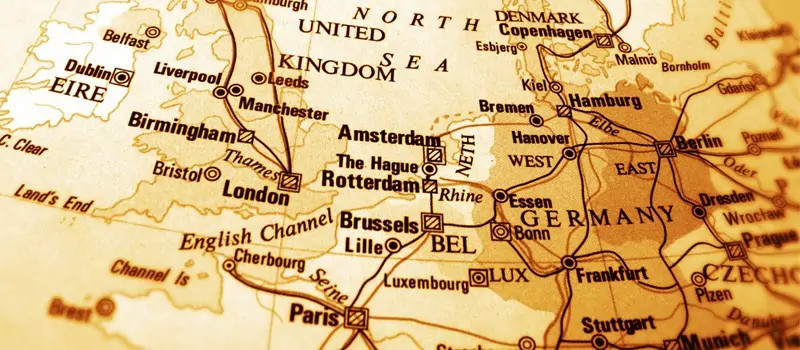Sorting out your Western European ethnicity can be tough. Some genealogical DNA testing companies use very broad terms. Others break it down by country, or even smaller. But sometimes, no matter what label they used, your results just don’t make sense based on the family history research you’ve done so far.
There are a lot of factors that go into your Western European ethnicity, and a lot of different groups that get lumped together. Read on, and we’ll try to sort through the confusion.
What is Western Europe?
Exactly what gets called Western Europe depends on who you ask. Generally, at a minimum it includes modern day Germany, France, Belgium, Netherlands, Luxembourg, Lichtenstein, and Switzerland. In some cases, it may also include Austria, western Poland, the Czech Republic, and Denmark.
In the past, some genealogical DNA testing companies also included the British Isles and Scandinavia, but today those are treated as separate regions.
One of the biggest problems with sorting out European ethnicity is that it isn’t as well defined as other areas. There are fewer physical barriers preventing people from moving back and forth all over Western Europe. That means there was more genetic blending than we see in many regions.
The first Europeans
Many groups migrated into and across Europe throughout the ages. Sometimes they came peacefully; sometimes they came as invaders.
Europeans were nomadic hunter/gatherers until the spread of agriculture some 6,000 to 8,000 years ago. Farmers arrived from the Middle East, bringing new crops and domesticated animals with them. Each group eventually found somewhere to stop and put down roots. After living in the same region for century after century, those groups began to develop the distinct genetic identities that we call ethnicities.
The Celts
One of the first unique cultures to emerge in Europe were the Celtic tribes, some 2,500 years ago. They appeared in central Europe, around modern Austria, and spread gradually westward until reaching western Germany and eastern France. Some went on to cross the English Channel and inhabit the British Isles. They spread their influence across much of Western Europe, along with their language and customs. They even invaded Italy and sacked Rome in the 4th century B.C.
However, the domination of the Celts didn’t last. While the Celts remain a major group today in the British Isles, they are much less prominent in Western Europe, mainly due to the Germans and the Romans.
The Germanic tribes
The Germanic tribes originated mainly in areas now known as Scandinavia. Around the 5th century B.C., they began pushing south out of Sweden, Denmark, and northern Germany, perhaps in response to climate changes. They gradually overwhelmed the Celtic tribes who had remained in Europe, until only those in France remained. But before they could go much further, the Romans arrived.
The Romans
Although the city of Rome was founded in the 8th century B.C., it took several hundred years for the Roman Empire to become the dominant military, political, and cultural force in Southern Europe. But by the 1st century B.C., Rome had consolidated its power in the Mediterranean, and was ready to start pushing north, led by generals like Julius Caesar.
Armed with better weapons, tactics, and discipline, the Roman legions drove their way through the Celtic-controlled region of Gaul (modern day France), across the English Channel, and all the way up to southern Scotland. They controlled the area for a couple hundred years and brought in a flood of fresh DNA.
The Germanic tribes, part two
Rome’s power and influence began to wane by 400 A.D., leaving Western Europe up for grabs. At the same time, invaders from the Central Asia and the Middle East began to push Europeans east, including the Germanic Vandals and Goths. In all, seven major Germanic tribes pushed their way into territory previously under Roman rule, and even sacked Rome itself. This period saw a vast wave of migration into and around Western Europe.
One of the Germanic groups, the Franks, eventually consolidated power over much of the area. By 800 A.D., the Frankish king Charlemagne controlled an area covering nearly all of Western Europe. He was crowned “Emperor of the Romans” by Pope Leo III, and the area became known as the Holy Roman Empire.
More on Germanic Europe ancestry.
Other invaders
Following the collapse of Rome’s power, Celts from the British Isles made their way back onto the continent and established Brittany, in northwestern France. Viking settlers also began to arrive, and their descendants became the Normans, who controlled northern France and, in 1066 A.D., invaded the British Isles once again.
Things mostly settled down about a thousand years ago in terms of new genetic material entering the region, but this is a much shorter time span than many other regions. Because of that, Western Europe is genetically more diverse. And that makes it harder to use genealogical DNA testing to narrow down specific locations.
“My report shows too little Western European ethnicity”
If you’ve done your research and know that most of your ancestors came from France, Germany, or other countries in Western Europe, you would expect your genealogical DNA profile to show that. But what if it doesn’t? What if the percentage you get is a lot lower than you expected?
That doesn’t mean the test is wrong, and it doesn’t mean your research is wrong, either. Consider what other regions might contribute to your genetics:
- Scandinavia – Many Vikings settled in Western Europe, especially along the northern coast. Read more about Scandinavian DNA.
- British Isles – Your ancestors may have a strong Celtic influence, meaning your ancestors were closely related to Celts in the British Isles, even if they never lived there.
- Southern Europe – This could indicate Roman genes that have survived over the centuries. Or it may include a more recent peaceful migration.
“My report shows too much Western European ethnicity”
A lot of different groups invaded Western Europe at various times. And at various times, people from Western Europe invaded right back. If your research shows your ancestors lived outside of Western Europe, but your genes say otherwise, consider how those genes got there.
- British Isles – Both the Anglo-Saxons (a Germanic tribe) and the Normans (descended from Vikings) invaded England and settled there. Modern DNA tests can usually take this into account, but not always.
- Eastern Europe and Southern Europe – The Germanic tribes sacked Rome, and not all of them went home afterwards. Napoleon’s troops fought their way across Poland and into Russia. Many smaller invasions took place in-between. These all carried Western European genes to other regions.
- Middle East – In the same way, Crusaders ventured through Southern Europe and into the Middle East on several occasions, leaving many children behind.
- Africa, Southeast Asia, and South America – The French, Germans, and Dutch all began colonial expansion around the world beginning in the 17th century. Even the Belgians got in on the act by the 20th century. That means Western Europeans lived (and had children) all over the world.
Trust your research
I was shocked when I took an mtDNA test with FamilyTreeDNA and discovered my ancient maternal origins lie in and around modern-day Turkey. Shocked because everyone on my mother’s maternal line is Italian. But after doing a bit more research into the area of Italy they were from, I found that it was frequently invaded by the Turks 500 years ago.
Genealogical DNA tests, such as those offered by AncestryDNA, 23andMe, MyHeritage, LivingDNA, and FamilyTreeDNA, can be a great addition to your family history search. They provide new insight into your genetics, and can help you track down missing ancestors. But they have their limits.
Ethnicity estimates are getting better all the time, but it’s still only an estimate, and there are a lot of confounding factors. In the end, if your research is telling you one thing, and your DNA test is telling you something else, trust your research.
But if you’ve hit a brick wall, or just don’t know where to begin, a genealogical DNA test can be the perfect way to dig up your family’s roots.



